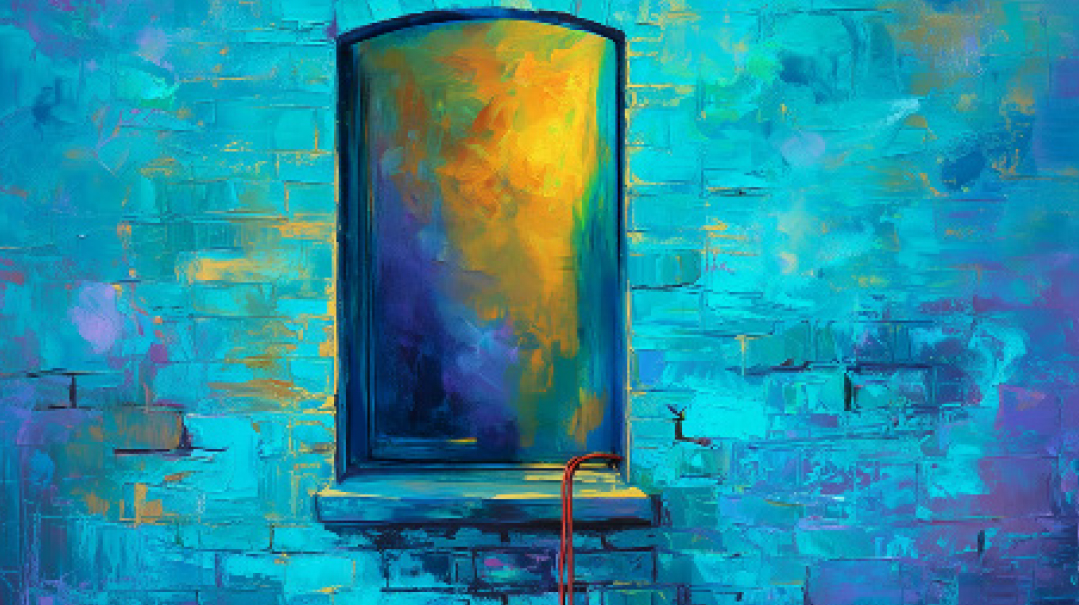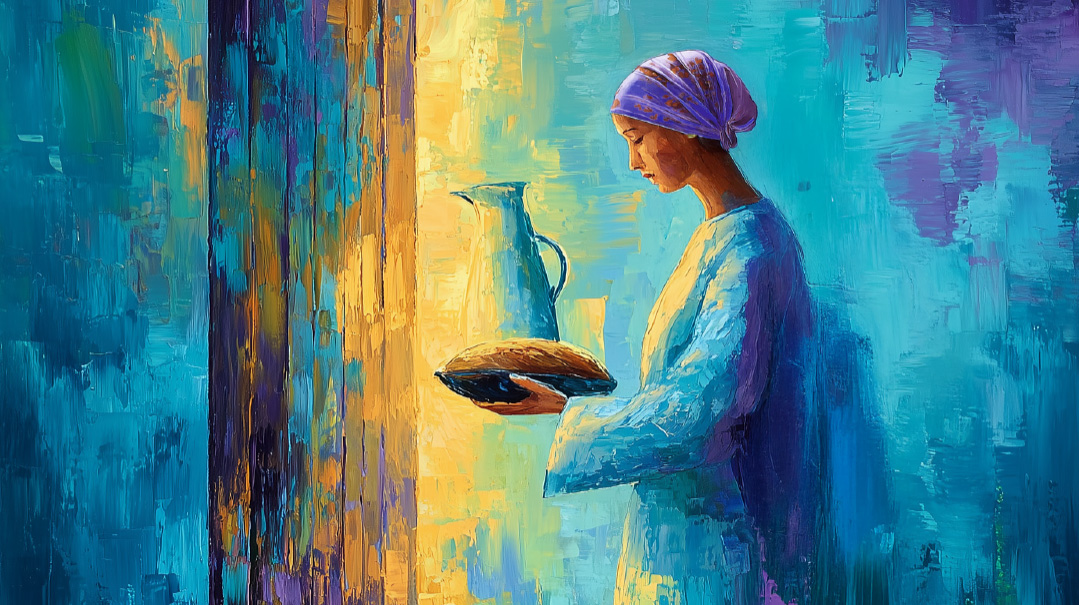Light Up the Darkness
| December 17, 2024Straddling two worlds, we need tools for two realities
וַתָּקָם בְּעוֹד לַיְלָה, וַתִּתֵּן טֶרֶף לְבֵיתָהּ וְחֹק לְנַעֲרֹתֶיהָ
Let’s look at the woman behind this impressive image of someone who arises when it’s still night to get her home running. While some of us are morning people, it’s often necessity that gets us out of bed before the light of day, and for many, it’s a struggle.
The Beis Aharon, the fourth Rebbe of Karlin, suggests a deeper reference in this pasuk. This world is a place of darkness for the soul, and it’s continuously challenged to emerge from the darkness that the veil of physicality imposes, into the light.
We’re born with all of our spirituality within us in potential, a shining light within (Rav Dessler), and each moment we’re given the opportunity to reveal another sliver of that light in the world. Being a child has its own darkness, as choices are made for us, and there is so much we need to learn. The yetzer tov checks in at bar or bas mitzvah, helping us to navigate the confusion of adolescence.
The greatest gift we were given is that of bechirah, which means that we have it within us to choose to get up and awaken our soul, even though it’s still dark. Though this is what we were put here to do, life’s circumstances, when less than optimum, can cause confusion, make us want to withdraw, or be angry. It is specifically the effort of trying to arise while it’s still night for us to reveal the presence of Hashem within us that brings us the light of clarity that is a gift from Above, and is a response to the effort (sometimes Herculean) that we make to find His light in the darkness. It’s the “vatakam b’od lailah” that brings an outpouring of abundance from On High.
Each of us, in our own life’s orbit, is given the opportunity to step out of the darkness and shine His presence that exists within us. It could be physical darkness, as when we are called upon to fulfill our obligations with a smile, even though we don’t feel well and just want to be in our beds. We could be experiencing an “emotional night” as we watch our friend’s children 20 years our junior get engaged, and we have to dig to find the G-dliness within us to participate in the simchah to the best of our abilities.
We are all warriors, and every effort we make to find Hashem in our own darkness helps our people emerge from the darkness of galus into the ultimate light of redemption.
Debbie Greenblatt is a senior lecturer for the Gateways organization and a teacher of both the observant and the not-yet-observant. She is also director of education at Core.
A Means to an End
I feel like we’re wavering between two existences. I run between PTA conferences, simchahs, end-of-season sales. In the background, there’s grief, war, and always more Tehillim. This pasuk gives us the tools to live in both realities.
For the day-to-day, the pasuk teaches us that the eishes chayil gets up before dawn to provide her family and employees with the food and things they need to be successful. Those among us who aren’t morning people (cough, cough) can still fulfill this mandate. By preparing for life in advance of the deadline, we create a home that is calm, not stressful, which helps our families become their best.
The Ralbag says that our physical work caring for our family is really a means to an end. Without basic health, we cannot focus on our spiritual world. All the mundane work we do, the doctor’s appointments, cooking meals, buying clothes, and exercise allows our family to grow spiritually.
The derash of the pasuk teaches us how to deal with the heavier parts of life, too. The pasuk also means that the eishes chayil gets up in galus, in Olam Hazeh, and raises herself spiritually. She models spiritual living for her children and her community so they can earn their own Olam Haba.
This summer, the Baltimore community was struck with the tragic passing of a young mother, Rena Baron a”h. Her sister Rebecca has shared her insights in articles and videos about guiding children to deal with tragedy in a healthy way, with bitachon.
May we never know such darkness, but we can use their example as a model for guiding our children in dealing with their own personal nights. We can help them cope with childhood setbacks with bitachon.
When we raise ourselves spiritually and live a life of emunah, our children watch us. They see our acts of chesed, the Tehillim we say, that we’re nosei b’ol, that we have bitachon, and they learn how to face their life challenges, too.
This is our work in This World. On the one hand, we take care of the gashmiyus, staying grounded as we shop, cook, and play. We try to be as organized as possible so that everyone has menuchas hanefesh. And we work on building our Olam Haba, and on the ruchniyus of our children, so they, too, can lead lives with bitachon in Hashem.
Question: When my family and friends are faced with challenges, how can I be a model for dealing with those challenges?
Shira Hochheimer is the author of Eishes Chayil: Ancient Wisdom For Women of Today and a presenter for Torat Imecha Nach Yomi.
Bisya’s Chesed
This pasuk refers to Bisya, the daughter of Pharaoh. She’s mentioned among righteous women for her role in saving and raising Moshe Rabbeinu. We’re told she received an unusual reward: She entered Gan Eden while still alive.
Chazal teach us that Bisya had gone down to immerse herself in the Nile as part of the conversion process. It was then that she saw baby Moshe in a basket on the water. The Brisker Rav notes that these two events are interconnected. The Torah tells us, “Vatachmol alav,” she had compassion for him because this is one of the hallmarks of a Jew: We’re baishanim, rachmanim, and gomlei chasadim.
Rav Avraham Hofta in Eshel Avraham describes the greatness of Bisya’s deed. She had no idea that he would be the future redeemer of the Jewish people. She acted with basic decency by saving him. But she didn’t stop there. She took him home, provided a nursemaid, and cared for him as her own. She models doing chesed without a personal agenda.
Rashi comments that she saw the Shechinah hovering above the child’s head; her selflessness made her worthy of perceiving the Divine. This is an example of Chazal’s maxim, “Bederech she’adam rotzeh lailech molichin oso —on the path that one wishes to proceed, One [Hashem] will lead him."
Rav Chaim Shmuelevitz ztz”l explains that saving Moshe despite the decree to kill all the Jewish babies was an act of mesirus nefesh. This mesirus nefesh was then infused into Moshe Rabbeinu’s persona. His capacity to advocate for his people despite their monumental failings came from Bisya’s actions. The name she gave him, “Moshe, one who is drawn from the water,” is the only one used in the Torah, reminding us of the reward for acting selflessly.
Many other miracles happened to Bisya when she went to save Moshe. Rav Shraga Grossbard ztz”l in Da’at Shraga says that her maidservants tried to prevent her from saving the baby and they died, Bisya was cured of leprosy, and her arm stretched unnaturally to reach the baby. The lesson here is that people can experience miracles and choose to ignore them. One must be attuned, as Bisya was, to seeing Yad Hashem.
“She rises while it’s still night.” To do this requires the qualities modeled by Bisya: compassion, generosity, and mesirus nefesh. She shows us to seek truth and connection to the Divine. She’s truly a righteous woman.
Rebbetzin Shira Smiles is a lecturer in the Yerushalayim area, and a mechaneches in Darchei Binah Seminary.
(Originally featured in Family First, Issue 923)
Oops! We could not locate your form.







